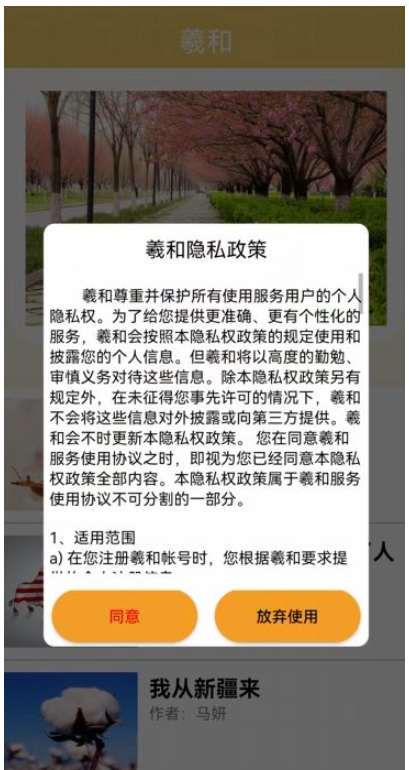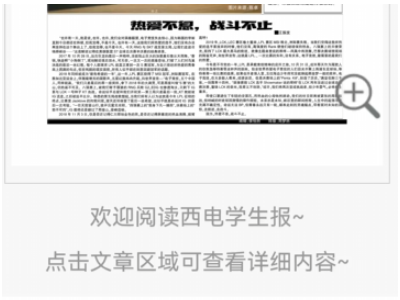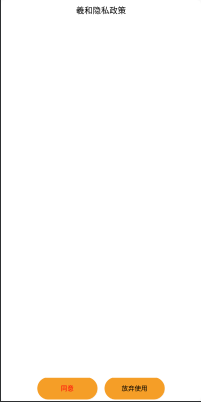您好,登錄后才能下訂單哦!
您好,登錄后才能下訂單哦!
這篇文章主要講解了“Android怎么實現隱私政策彈窗與鏈接功能”,文中的講解內容簡單清晰,易于學習與理解,下面請大家跟著小編的思路慢慢深入,一起來研究和學習“Android怎么實現隱私政策彈窗與鏈接功能”吧!
先展示效果,看看是不是你需要的。


在drawable文件夾下新建button_shape.xml
<?xml version="1.0" encoding="utf-8" ?> <!--相當于做了一張圓角的圖片,然后給button作為背景圖片--> <shape xmlns:android="http://schemas.android.com/apk/res/android" android:shape="rectangle"> <!--設置背景色--> <solid android:color="#F59E27" /> <!--設置圓角--> <corners android:radius="105dip" /> <padding android:bottom="2dp" android:left="33dp" android:right="33dp" android:top="2dp"> </padding> </shape>
在drawable文件夾下新建dialog_privacy_shape.xml
<?xml version="1.0" encoding="utf-8"?> <shape xmlns:android="http://schemas.android.com/apk/res/android" android:shape="rectangle"> <!-- 填充色 --> <solid android:color="#ffffff" /> <!-- 矩形圓角半徑 --> <corners android:radius="10dp" /> </shape>
在assets文件夾下新建privacy.txt,內容為彈窗主體信息。
在layout文件夾下新建一個布局dialog_privacy_show.xml
<?xml version="1.0" encoding="utf-8"?> <LinearLayout xmlns:android="http://schemas.android.com/apk/res/android" xmlns:tools="http://schemas.android.com/tools" android:layout_width="match_parent" android:layout_height="match_parent" android:background="@drawable/dialog_privacy_shape" android:orientation="vertical"> <RelativeLayout android:layout_width="match_parent" android:layout_height="match_parent"> <LinearLayout android:layout_width="match_parent" android:layout_height="match_parent" android:layout_above="@+id/ll_btn_bottom" android:layout_marginBottom="15dp" android:gravity="center" android:orientation="vertical"> <TextView android:id="@+id/tv_title" android:layout_width="wrap_content" android:layout_height="wrap_content" android:layout_marginTop="10dp" android:layout_marginBottom="10dp" android:text="羲和隱私政策" android:textColor="#000000" android:textSize="18sp" /> <ScrollView android:layout_width="match_parent" android:layout_height="match_parent" android:layout_marginLeft="5dp" android:layout_marginRight="5dp" android:fadingEdgeLength="50dp" android:requiresFadingEdge="horizontal"> <TextView android:id="@+id/tv_content" android:layout_width="match_parent" android:layout_height="match_parent" android:layout_marginTop="10dp" android:singleLine="false" android:text="" android:textColor="#000000" /> </ScrollView> </LinearLayout> <LinearLayout android:id="@+id/ll_btn_bottom" android:layout_width="match_parent" android:layout_height="wrap_content" android:layout_alignParentBottom="true" android:gravity="center" > <Button android:id="@+id/btn_agree" android:layout_width="130dp" android:layout_height="wrap_content" android:layout_marginBottom="2dp" android:layout_marginRight="15dp" android:text="同意" android:onClick="onClickAgree" android:textColor="#FF0006" android:background="@drawable/button_shape"/> <Button android:id="@+id/btn_disagree" android:layout_width="130dp" android:layout_marginBottom="2dp" android:layout_height="wrap_content" android:text="放棄使用" android:onClick="onClickDisagree" android:textColor="#000000" android:background="@drawable/button_shape"/> </LinearLayout> </RelativeLayout> </LinearLayout>
效果:

新建一個活動yinsi.xml
先寫活動布局
<LinearLayout android:layout_width="match_parent" android:layout_height="30dp" android:orientation="horizontal" android:gravity="center" xmlns:android="http://schemas.android.com/apk/res/android"> <TextView android:layout_width="wrap_content" android:layout_height="wrap_content" android:text="點擊查看" android:textSize="14sp" /> <TextView android:id="@+id/tv_xieyi" android:layout_width="wrap_content" android:layout_height="wrap_content" android:onClick="onClickPrivacy" android:text="隱私政策" android:textColor="#0000ff" android:textSize="14sp" /> </LinearLayout>
再修改活動的java文件,實現點擊鏈接可以跳出彈窗
package cn.edu.cdut.xihe;
import androidx.appcompat.app.AppCompatActivity;
import android.app.AlertDialog;
import android.app.Dialog;
import android.os.Bundle;
import android.util.DisplayMetrics;
import android.view.LayoutInflater;
import android.view.View;
import android.view.WindowManager;
import android.widget.TextView;
import java.io.BufferedReader;
import java.io.IOException;
import java.io.InputStream;
import java.io.InputStreamReader;
import java.io.UnsupportedEncodingException;
public class yinsi extends AppCompatActivity {
Dialog dialog;
@Override
protected void onCreate(Bundle savedInstanceState) {
super.onCreate(savedInstanceState);
setContentView(R.layout.activity_yinsi);
}
public void onClickAgree(View v)
{
dialog.dismiss();
}
public void onClickDisagree(View v)
{
finish();
}
public void onClickPrivacy(View v)
{
showPrivacy("privacy.txt");//放在assets目錄下的隱私政策文本文件
}
public void showPrivacy(String privacyFileName)
{
String str = initAssets(privacyFileName);
final View inflate = LayoutInflater.from(yinsi.this).inflate(R.layout.dialog_privacy_show, null);
TextView tv_title = (TextView) inflate.findViewById(R.id.tv_title);
tv_title.setText("羲和隱私政策");
TextView tv_content = (TextView) inflate.findViewById(R.id.tv_content);
tv_content.setText(str);
dialog = new AlertDialog
.Builder(yinsi.this)
.setView(inflate)
.show();
// 通過WindowManager獲取
DisplayMetrics dm = new DisplayMetrics();
getWindowManager().getDefaultDisplay().getMetrics(dm);
final WindowManager.LayoutParams params = dialog.getWindow().getAttributes();
params.width = dm.widthPixels*4/5;
params.height = dm.heightPixels*1/2;
dialog.getWindow().setAttributes(params);
dialog.getWindow().setBackgroundDrawableResource(android.R.color.transparent);
}
/**
* 從assets下的txt文件中讀取數據
*/
public String initAssets(String fileName) {
String str = null;
try {
InputStream inputStream = getAssets().open(fileName);
str = getString(inputStream);
} catch (IOException e1) {
e1.printStackTrace();
}
return str;
}
public static String getString(InputStream inputStream) {
InputStreamReader inputStreamReader = null;
try {
inputStreamReader = new InputStreamReader(inputStream, "UTF-8");
} catch (UnsupportedEncodingException e1) {
e1.printStackTrace();
}
BufferedReader reader = new BufferedReader(inputStreamReader);
StringBuffer sb = new StringBuffer("");
String line;
try {
while ((line = reader.readLine()) != null) {
sb.append(line);
sb.append("
");
}
} catch (IOException e) {
e.printStackTrace();
}
return sb.toString();
}
}1.由于新建的是一個活動,因此該鏈接可以放到其它的布局文件中,用include引入。
2.一般來說,用戶首次啟動才需要彈窗,可以在主頁面的啟動中加入彈窗程序,并加入一個判斷是否首次啟動。
3.這里點擊鏈接是出現彈窗,更多情況是點擊鏈接會跳轉到相應政策頁面,這里沒做進一步編寫,寫一個WebView分裝網頁文件即可。
感謝各位的閱讀,以上就是“Android怎么實現隱私政策彈窗與鏈接功能”的內容了,經過本文的學習后,相信大家對Android怎么實現隱私政策彈窗與鏈接功能這一問題有了更深刻的體會,具體使用情況還需要大家實踐驗證。這里是億速云,小編將為大家推送更多相關知識點的文章,歡迎關注!
免責聲明:本站發布的內容(圖片、視頻和文字)以原創、轉載和分享為主,文章觀點不代表本網站立場,如果涉及侵權請聯系站長郵箱:is@yisu.com進行舉報,并提供相關證據,一經查實,將立刻刪除涉嫌侵權內容。